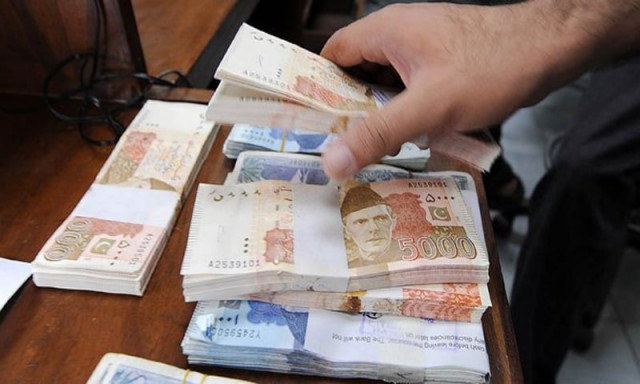Govt pitches Rs5.8tr tax target
Informs IMF about proposals of Rs350b additional taxes, 10% hike in salaries

Pakistan on Monday informed the International Monetary Fund (IMF) that it plans to give 10% raise in salaries over and above a disparity allowance and pitched a Rs5.8-trillion tax target for the next fiscal year.
The government also proposed to levy Rs350 billion worth of additional taxes in the budget including Rs81 billion measures that have already been implemented through a mini-budget. The Rs350 billion worth of additional revenue measures are nearly half of what former finance minister Dr Abdul Hafeez Shaikh had agreed with the IMF in March this year.
The government also pitched 5.2% economic growth rate target for the next fiscal year during first technical level interaction with the IMF staff, said finance ministry sources. The IMF would now review these figures and give its response in coming days whether it was willing to accept these figures, said the sources.
The non-tax revenues target will be around Rs2 trillion, to be achieved on back of about Rs650 billion profits by the State Bank of Pakistan (SBP) and Rs650 billion to Rs700 billion collection under petroleum levy, said the sources. The finance ministry officials informed that it planned to continue 25% disparity allowance in the next fiscal year, which it had given a couple of months ago to end protests by the employees. Over and above the disparity allowance, the government may give minimum 10% increase in salaries and pensions to civilian and armed forces employees, said the sources.
The finance ministry has suggested 5.2% economic growth target for the next fiscal year after the National Accounts Committee approved 3.94% growth figure for outgoing fiscal year. The inflation is expected to be targeted around 8% in the next fiscal year.
Sources said that the government proposed Rs5.8 trillion tax target for the next fiscal year, which is about Rs163 billion less than what the IMF had suggested. This year collection is expected to be Rs4.7 trillion.
To achieve this target, the government proposed Rs350 billion worth of revenue measures, including Rs81 billion taxes that it imposed with effect from March through a Presidential Ordinance, and will be protected in the next budget.
The income tax measures will be around Rs100 billion with fresh measures of just Rs20 billion on account of personal income tax. Sources said that the government informed the IMF that it would not put any significant burden on the salaried class, except on higher income brackets.
But it stands ready to reduce the number of income tax slabs, said the sources. They said that the net impact on salaried class could be Rs5 billion as against earlier proposal of Rs24 billion. There might be Rs190 billion worth of sales tax measures in the budget, which are also half than what Pakistan had committed at the time of revival of the $6 billion programme. Sources said that the government could take Rs60 billion worth of customs duties measures in the next budget.
Still there will be about Rs200 billion gap between the revenue target and the measures proposed to achieve it, which the sources said, the government would try to cover through administrative measures like bringing retailers in the tax net and introducing track and trace system to curb tax evasion.
There are 100 million mobile users paying adjustable 12.5% tax and three million retailers paying non-adjustable sales tax and up to Rs43,500 income tax. But the FBR remains unable to catch this potential. It also has a record of eight million people paying huge withholding tax. But this information has never been translated into revenues.
Finance Minister Shaukat Tarin on Monday hinted at lowering the minimum income tax rate in the budget, which Pakistan’s corporate sector has described flawed and a barrier to entry of new companies.
Tarin promised to look into the possibility of reducing the minimum income tax from its current rate of 1.5% from fiscal year 2021-22 during a meeting with representatives of the country’s big corporations, finance ministry sources said.
Tarin held a consultative meeting with senior representatives of Pakistan Business Council, Pak-US Business Council and Overseas Investment Chamber of Commerce and Industry (OICCI).
The Pakistan Business Council has said that rate of minimum tax of 1.5% was extremely high and unrealistic which is based on turnover of a company instead of its profits.
The PBC has termed this mechanism flawed and a barrier to entry of new players as it raises the initial investment required to cover tax payable in early loss years. FBR’s reliance on minimum, advance and withholding taxes has grown sharply as this is an easier way than assessing taxable profits, according to the PBC.
The big firms particularly want that the turnover tax on the oil companies should be drastically reduced to only 0.11%.
The Pakistan Business Council has said that rate of minimum tax of 1.5% was extremely high and unrealistic which is based on turnover of a company instead of its profits.
The corporate sector also demanded from the government that the turnover tax on zone operators of the Special Economic Zones be also lowered.
However, finance minister refused to restore the section 65 D and 65E, which were related to tax incentives on new investments but were withdrawn through a mini-budget a couple of months ago, said the sources.
Under section 65D and 65E there was exemption for five years from all income taxes, including minimum tax and final tax, to company formed for operating a new industrial undertaking.
Tax Credit under section 65B, which was available to industrial undertaking has been prematurely withdrawn whereas tax credits under sections 65D and 65E will expire on June 30, 2021. In order to encourage companies to invest in plant and machinery, either for import substitution or export growth, all tax credits on investments should be immediately revived.
Published in The Express Tribune, May 25th, 2021.
Like Business on Facebook, follow @TribuneBiz on Twitter to stay informed and join in the conversation.

















COMMENTS
Comments are moderated and generally will be posted if they are on-topic and not abusive.
For more information, please see our Comments FAQ